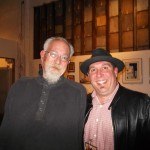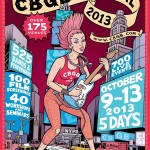The rock world lost one of its pioneering concert poster artists on Monday when Gary Grimshaw passed away at the age of 67 in his home town of Detroit after a long battle with a variety of illnesses.
Grimshaw was best-known for the iconic psychedelic posters he created for concerts at Detroit’s Grande Ballroom, part of a circuit of 60s venues that played host all the major rock bands of the time from homegrown heroes to visiting British artists such as the Who, Cream, the Jeff Beck Group, Led Zeppelin and Pink Floyd. Grimshaw was also closely associated with the MC5, which served as the Grande’s house band.
“I wanted to do posters like they were doing out in San Francisco, at the Fillmore, and (MC5 frontman) Rob Tyner, recommended Gary,” Grande owner Russ Gibb said after learning of Grimshaw’s death. “He was the easiest guy in the world to work with; I’d give him the outline, never said what to do and how to do it, and he did it great, always.”
| Gary Grimshaw’s Work — Click Here for More |

Love-In Detroit at Belle Isle, 1967 |

Jim Hendrix at the Masonic, 1968 |
MC5 guitarist Wayne Kramer, who along with Tyner grew up with Grimshaw in Lincoln Park, south of Detroit, remembered that, “As kids, Gary Grimshaw was the best artist in our neighborhood,” said MC5 guitarist Wayne Kramer, who grew up with the Detroit-born Grimshaw in Lincoln Park. “We drew hot rod cars and he knew the secret of how to capture chrome, which made him the coolest to a greaser like me. Of course, Gary became a truly great artist and friend and his art made the world a more beautiful place.”
Grimshaw’s art — highly collectible and even enshrined in the Rock and Roll Hall of Fame + Museum in Cleveland — has long been considered as representative of the 60s counterculture era as the work done by any of his counterparts on either coasts.
“He started an art form that wasn’t there prior,” noted Tony D’Annunzio, director of the documentary “Louder Than Love: The Grande Ballroom Story.” “He wasn’t a musician, but that whole culture that was going on then, he wanted to be part of it. When he got the chance, he jumped at it.”
Scott Morgan of the Rationals and Sonic’s Rendezvous Band recalled Grimshaw’s posters as “just excellent work. It really caught the spirit and the energy of the times.”
Grimshaw, who served in the U.S. Navy during the early 60s, was also part of Detroit’s burgeoning political and anti-war movements. He served as the Minister of Art for the White Panther Party and also worked for the Rainbow Peoples Party, the Detroit Artists Workshop, the Fifth Estate underground newspapers and Trans-Love Energies. He was also responsible for overturning the city of Detroit’s obscenity ordinance in 1969, when the Michigan Court of Appeals overturned a lower court ruling that one of his works was obscene. He lived briefly in the San Francisco Bay Area during the a late 60s and early 70s, then returned for a 14-year stay in the late 80s.
Besides posters, he contributed artwork to the Ann Arbor Sun, the San Francisco Oracle and other underground publications, and he was associate art director for Creem magazine. He and photographer Leni Sinclair published the book “Detroit Rocks: A Pictorial History of Motor City Rock and Roll (1965 to 1975)” in 2012, and in recent years he continued to make posters for bands, including the White Stripes and the Detroit Cobras, and had begun actively exhibiting and licensing his work. He visited Brooklyn during the fall for successful exhibitions and signings.
Grimshaw is survived by his wife, Laura, and their son, Alan, who is also an artist and designer. Funeral arrangements for this weekend are pending, while “A Night of Good Love,” which was intended to be a benefit for Grimshaw, will go on as a memorial on March 22 in Mount Clemens, Mich., with performances by Scott Morgan, Dick Wagner & Friends and Gary Quackenbush of SRC. More information about Grimshaw can be found at www.garygrimshaw.com.
http://www.billboard.com/articles/news/5869661/gary-grimshaw-dead-psychedelic-rock-poster-artist-dies






